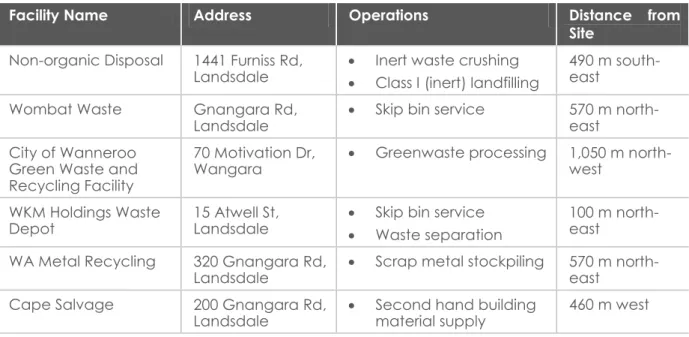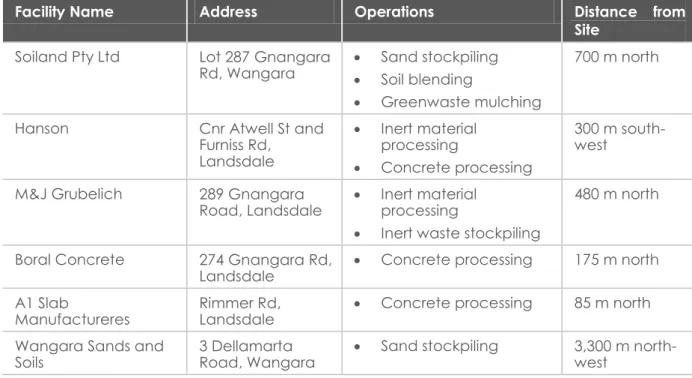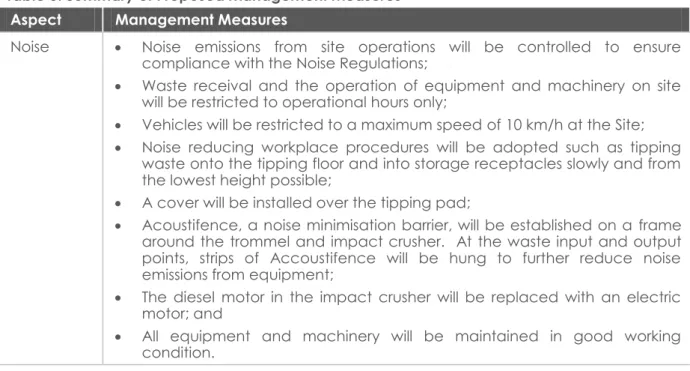Copyright of these documents or any part of these documents remains with Talis Consultants Pty Ltd and may not be used, transferred or reproduced in any manner or form without the prior written permission of Talis Consultants Pty Ltd.
Background
Purpose of the Report
In order to increase the efficiency of the consent process, the environmental and urban planning consent processes will take place simultaneously.
Scope of the Report
Site Location
Site Description
Site Access
Surrounding Land Uses
Separation Distances
3 – Separation distances between industrial and sensitive land uses 2005 contains the recommended minimum separation distances between industrial activities, including waste management facilities and sensitive land uses. Sensitive land uses are defined as those sensitive to industrial emissions and include housing developments, schools, hospitals, shopping centers and other public areas and buildings. The recommended minimum separation distances between sensitive land uses and the prescribed premises categories required for the site are shown in Table 3.
Several of the land uses around the Site (school and residential development) are classified as sensitive land uses. The nearest sensitive land uses are located outside the recommended 200 m separation distance for Category 62 activities, and within the recommended 1,000 m separation distance for a Category 13 Prescribed Premises. In addition to the management measures, the topography of the site provides a natural boundary to the movement of emissions off site.
Furthermore, it should be noted that there are similar facilities in the area that have a smaller separation distance to sensitive receptors, as shown in Figure 4. This includes an inert landfill that undertakes significantly greater crushing activities than those proposed for the Site.
Zoning
Topography
Geology
Flora and Fauna
Environmentally Sensitive Areas
Groundwater
Surface Water
Cultural Heritage
Aboriginal Heritage
European Heritage
Local Government Heritage
Contaminated Site Information
Summary of Environmental and Social Attributes
The site slopes down from the eastern divide with a steep cut back along the western and northern divide. Groundwater Depth to groundwater varies from 5m along the eastern boundary to 9m in the north-west corner. Information The site is not classified as a contaminated site in DEC's database of contaminated sites.

Waste Acceptance
Waste Inspection
C&D Materials Processing
Primary Sorting
Once accepted, the liquid waste stream will be placed on the covered concrete pour area for manual removal of bulky items such as cardboard, green waste or metals. These items will be transferred to the appropriate containers located along the northern boundary of the Site. The remaining smaller material will be consolidated on the tilting block until sufficient volume (approximately 100 – 200 m3) has been accumulated.
This will ensure that sufficient raw material is available for the secondary sorting, inert crushing and screening process which is undertaken continuously for the rest of the day's working hours, thus maximizing the efficiency of the processing equipment. Once the stockpile reaches the appropriate minimum size, the waste stream will be transferred to the feed conveyor using a front loader. To minimize dust generation during primary sorting, loads will be sprayed onto the tumbling floor.
Secondary Sorting
Inert Crushing and Screening
Material Holding and Transportation
Site Equipment and Machinery
The tilt block, where primary sorting will be carried out, will be covered with a sea container cover.
Staffing
Operational Hours
To ensure that appropriate management measures are in place, Talis has identified all potential key environmental aspects associated with the proposed on-site operations. The source and potential impacts associated with these aspects are described in the following sections.
Noise
Since the drum and conveyor are driven by an electric motor, the operation of this machinery will generate significantly lower noise emissions than other means, such as an internal combustion engine. The noise level from the drum will largely depend on the type of material passing through. The use of Accoustifence around the drum will ensure that the associated noise emissions for all processed materials are adequately controlled.
The existing topography of the site further minimizes noise emission to surrounding properties by providing a 3.5 m earthen barrier around the site activities. The control measures that will be implemented to control noise emissions at the site and ensure that they do not exceed assigned levels are described in section 6.1.
Dust
Odour
Stormwater
Traffic
Litter
Vermin
The management measures that will be adopted to ensure that any impacts arising from traffic movements at the site are appropriately managed are described in Section 6.5. To ensure that the potential environmental impacts identified will be appropriately minimized and managed, ERRR will implement the engineering and management measures described in the following sections.
Noise Emission Management
Dust Management
Shade cloth on the perimeter fence will be maintained to limit off-site movement of any dust generated. As previously mentioned, rainfall on the on-site buildings will be stored in three 80,000 L reservoirs. Based on current rainfall, these are expected to be replenished with rainfall for most of the year.
During the dry summer months, additional dust suppression water will be supplied by a water hauling contractor. Dust suppression will also be supported by noise reduction barriers above the cutter and crusher and site topography. It is anticipated that the implementation of the engineering and management measures listed above will be sufficient to manage dust on site.
Odour Management
Stormwater Management
Since the volume of stormwater will not increase as a result of the proposed operations, it is expected that the continuation of current stormwater management measures will be sufficient to ensure that no stormwater will leave the site.
Traffic Management
Litter Management
Vermin Control
If significant pest problems are experienced, ERRR will use professional services to eradicate pests from the site.
Security
Community Liaison
Summary of Proposed Management Measures
Dust The impact crusher will include a built-in dust suppression system consisting of sprinklers over the hopper and end of the conveyor belt; It will be used when equipment is in operation, tipping occurs or any other periods during which dust may be generated;. The shade cloth on the perimeter fence will be maintained to limit the movement off site of any dust generated;.
All food waste or other potentially smelly perishable waste delivered to the site will be stored in a designated storage container and taken to an appropriate perishable waste facility. All food waste or other potentially smelly perishable waste will be removed from the site within 72 hours of delivery to ensure decomposition does not take place on site;. Non-recyclable waste that can generate little odor, such as paper, plastic and mattresses, is stored in a designated container and removed from the site daily.
Wind levels on site will be continuously noted by staff and action taken if required. Traffic A maximum speed of 10 km/h will apply to all vehicles on site and will be clearly displayed at the site entrance; and. Waste All separated materials will be stored in closed containers to prevent the uncontrolled movement of waste around the Site.
The shade cloth on the perimeter fence will be maintained to ensure that debris generated is unable to migrate to neighboring premises; and. Any litter generated around the site and along fence lines will be collected on a daily basis as part of routine procedures. Vermin Any food waste or other potentially odorous decaying waste within accepted loads will be immediately removed and stored in the storage container for disposal.
All green waste will be stored in a designated container, which will be covered outside of opening hours. The generation of odor and waste will be minimized through the implementation of appropriate management measures; and. Liaison The register for the local community or surrounding land users to raise concerns will be maintained and responded to if necessary.
The spatial information recorded in the site file is considered reliable, due to methods of capture. The spatial information recorded in the site file is considered unreliable due to errors in the capture of spatial data and/or quality of spatial information reported.




